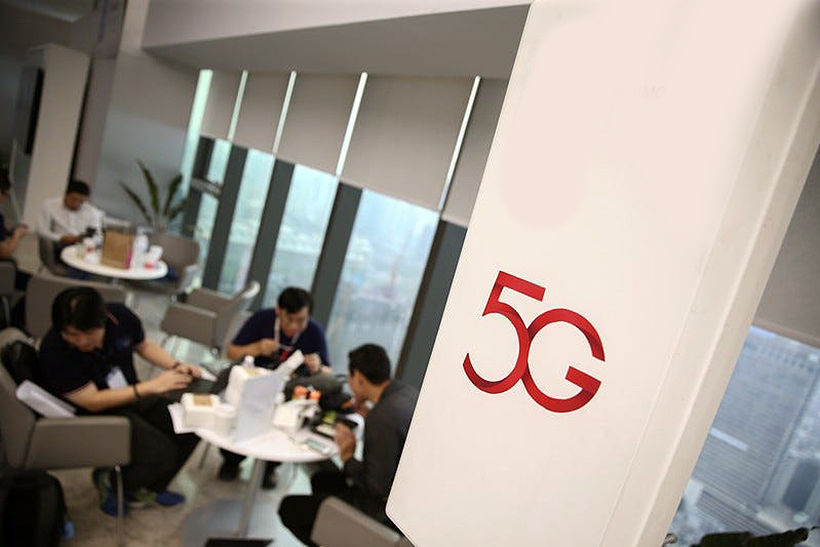What is 5G? Everything you should know about the next-gen mobile.

So what is 5G?
5G literally means fifth-generation wireless technology. The successor to 4G, the biggest changes include higher speeds, lower latency, and the ability to connect more devices at once. The benefits of 5G aren’t limited to its use. Qualcomm is predicting a $12.3 trillion economic boost worldwide, with 22 million new jobs thanks to both the infrastructure and technological developments required by 5G.
As of 2019, 5G is mostly relying on 4G connections, so its full capabilities are limited to test environments. But from 2020, when the standalone 5G network is deployed and enabled, the race to develop better, faster, more efficient IoT devices and processes means exponential growth and potential.
This is when we’ll start to see the impact of 5G – at work, at home, out and about. We’re already feeling the push of connected devices in and around the home, with Alexa, Siri, and Google talking to us more than some of our family members. But it’s at work that we can really start to imagine how 5G can benefit our customers, advance our products and services, and, ultimately, make us more money.
High speeds, low latency, more devices
4G speeds have been increasing all the time, but 5G promises data transfers at speeds around ten times faster than current 4G speeds. Maximum speed forecasts in ideal conditions are 20Gb/s, but for the average consumer, current maximum download speeds sit at around 100Mb/s.
There are really three different types of radio wave frequencies that 5G is using, but most telcos are using the 3.5GHz frequency band for 5G, which has produced speeds of above 490Mb/s. The highest speeds (up to 4000% faster than 4G) require new infrastructure to be built, called small cells, which are low-power base stations that will be dotted around business districts and households. These use millimeter waves (mmWaves) which are so short that they can’t go around buildings, over distances, or even around corners.
One of the most obvious benefits of 5G will be the lower latency; that’s the lag it takes for your phone to load a webpage, or for data to be sent across a network. But it’s not really going to make a huge difference on a device – this is where the ‘internet of things’ is really going to make an impression.
Current latency for a 4G network sits at around 60 milliseconds. With 5G, this is reduced to between 1-6 milliseconds. And for our AI maid Rosey, latency is again a key issue – she would need to react to external stimuli when navigating around a house (walls, people, misplaced items) and immediately respond by moving or stopping. Failure to do so could result in expensive damages that would make the cost of a robot prohibitive.
The other major improvement is the number of devices the network can handle. The standard for 5G requires that the network must support at least one million devices per square kilometer. This isn’t just for one million phones, though – by the year 2023, it’s estimated there will be 1.3 billion connections on the 5G network, ranging from phones through to fridges, cars to drones, and VR headsets that enable you to catch up with friends overseas as if you were really there.



When’s it coming?
According to Gartner, 7% of communication service providers have already deployed 5G. South Korea has pushed 5G out on a large scale, while major cities in the US, the UK, Switzerland, Finland, and Australia have 5G available commercially. Most of the 5G networks are currently piggybacking off the 4G hardware (known as a non-standalone connection), but in 2020, the standalone technology will start rolling out.
Gartner estimates that revenue from the 5G hardware installation will double to $4.2 billion in 2020. But all this takes time: globally, it’s not until 2024 that around 40% of people will be able to access 5G.
How will this affect the workplace?
Do you ever work from home? 70% of people globally working from home at least once a week, and over 50% working from home at least half of the week. This means that getting the technology right is more important than ever. The 2019 State of the Digital Workplace report from Igloo found that 70% of remote workers feel left out of the workplace, due to issues with not being able to access people, documents or information, and missing out on processes or policy changes.
5G is set to overhaul the way that technology functions and will make working from home feel like working in the office (without the bad coffee, freezing temperatures, and all-too-regular fire drills). Files that are on the network can be downloaded easily; meetings will feel seamless and lack the lag that often happens now; and collaboration will be straightforward and effective.
In addition to improvements in speed and efficiency, it’s via 5G that the IoT will come out of the age of sci-fi and into reality. A smart workplace could mean lighting, heating, and audio-visual preferences are enabled for each employee based on their location. Office admin tasks, from cleaning through to meeting planning, could be fully automated. Virtual meetings will improve productivity and efficiency. And this is only in an office environment – in other workplaces, like factories, the operating theatre, a busy kitchen – production and operation will be revolutionised with the automation capabilities of 5G.
Of course, automation and robots are already used extensively in the workplace, in health care, manufacturing, agriculture and food prep particularly. But the soft skills shown by the robots of yesteryear (think Rosey, C-3PO, HAL), require an extreme processing speed to respond to and “think” like their human colleagues.
While some of these technologies and capabilities already exist, slow speeds and rush-to-market performances have led to inconsistencies, data drop-outs, and a lack of thought around security.
Risks
There is a lot of talk about the risks that are associated with 5G, and they can be broadly put into two categories, cybersecurity, and health concerns.
Cybersecurity
4G technology can support about 4000 devices per square kilometer. 5G is expected to be able to support around one million devices per square kilometre using the mmWave spectrum. Data transfer is likely to be ten times faster than it is today. This obviously has implications for business security. Edge computing, where processing happens closer to the device, is amazing for speed and data usage, but it could also be a security concern when the data isn’t getting checked in a central database.
This device connectedness means more endpoints for attackers to get into a network, and once they’re in, the scope for widespread damage is as large as the network’s footprint. These devices can become a “botnet”, which hackers can use to launch Distributed Denial of Service (DDoS) attacks. These issues are already high on the priority list for 5G’s rollout, with recent research from the Neustar International Security Council (NISC) revealing that 75% of security professionals are concerned about the impact of bot traffic on their organizations, while DDoS attacks once again ranked as the greatest overall concern.
It’s not just the devices that are vulnerable – the small cell antennas that need to be deployed could become physical targets, and early-phase security software may not be able to stand up to attackers.
Having said that, any new technology will need to be tested, phased in, and deployed with extreme care and caution, and security companies will be working hard on preparing for any attacks that could potentially compromise the new wave of technology.
One of those is Nuclear Cyber, security partner of LiveTiles, an organization that provides dashboards, portals and intranets for businesses with a heavy focus on AI and analytics. With the rising number of employees working from home, and the huge number of newly-connected devices when 5G really hits, how can businesses protect themselves and their customers from attacks? Kurt Mueffelmann, CEO of Nuclear Cyber, says it’s not about preventing hacks; it’s about protecting the data.
“If a device gets hacked, what is the hacker trying to gain access to? Generally, it is some level of data; whether intellectual property, sensitive information like credit cards or health, financial results, etc. The question isn’t what you do to prevent the hack. Companies need to take a more data-centric approach on how to protect the ‘crown jewels’ of key information within an organisation. It’s a different paradigm, but one that is beginning to take shape in a more aggressive manner. Security needs to be the ‘nucleus’ of the intelligent workplace!”
Health Concerns
The high frequencies required by 5G mean that the range is much lower than today’s towers, and so small cell towers will be clustered around the landscape. 5G also requires line-of-sight, so another possibility (particularly for rural areas) are extensions of existing towers to make them taller.
But some people are concerned about the number of these small cell towers, because there is a higher level of electromagnetic radiation. RadiationHealthRisks.com states that, “Within the RF Radiation portion of the electromagnetic spectrum, the higher the frequency, the more dangerous it is to living organisms.”
Despite the fact that 5G electromagnetic waves are a higher frequency than 4G, the radiation that comes from these frequencies is non-ionizing (as opposed to ionizing, which is the radiation from the sun or from x-rays).
Dr Steve Novella, an assistant professor of neurology at Yale and the editor of Science-Based Medicine, states that, “With 5G the hazard is low—but non-zero—and the actual risk appears to be zero. We’ve picked up no signal in the real world.” The Australian Radiation Protection and Nuclear Safety Agency’s Dr Ken Karipidis said last year, “The only established health effect (of radiofrequency radiation) is that of rising temperature,” and cannot cause cancer.
mmWaves can be absorbed by the skin and the eyes, but only with high-intensity exposure. Regulation means that mmWave exposure must be low-intensity, so health consequences will likely be limited to prolonged exposure to those low-intensity mmWaves – and there is not enough data on this yet to make a determination.
Where to now for businesses?
For individuals, we’ll all eventually need a 5G compatible phone; Netflix will be faster and more reliable; gamers will feel the impact of streaming and subscriptions; VR headsets won’t leave us all looking like Daft Punk; and our smartwatches will cook dinner. AI in the house is overtaking Roomba – robotics start-up Aelous showed their as-yet-unnamed robot at the 2018 Consumer Electronics Show, and in the two years since, looks set to bring the first generation of house robot assistants to market.
But a recent Barclay study found that only 15% of businesses are thinking about how they can use 5G. So how should businesses prepare for its imminent arrival?
1. Decision-makers should start educating themselves (researching both within and outside their own industry) on how 5G is going to be used and rolled out
2. CTOs should be meeting with their tech providers and creating a timeline and blueprints for infrastructure, hardware upgrades and security systems
3. Department heads should start budgeting for 5G and its introduction – initially, there will be an increase in costs for new equipment.
But the potential for 5G in business leaves plenty of room for excitement, too, and organizations should also start thinking about how 5G could improve processes and production. The time to dream is now.
Sources
https://www.techradar.com/news/5g-how-will-businesses-benefit https://www.opensignal.com/blog/2019/06/20/5g-smartphone-users-experience-1118-mbps-average-download-speed
https://www.howtogeek.com/340002/what-is-5g-and-how-fast-will-it-be/
https://www.whistleout.com.au/MobilePhones/Guides/5g-in-australia-what-you-need-to-know
>https://www.3gpp.org/release-15 https://www.bloomberg.com/press-releases/2019-09-19/5g-network-rollouts-accelerate-as-lte-s-long-tail-extends
https://www.gartner.com/en/newsroom/press-releases/2019-08-22-gartner-forecasts-worldwide-5g-network-infrastructure
https://www.gartner.com/en/newsroom/press-releases/2019-08-22-gartner-forecasts-worldwide-5g-network-infrastructure
https://www.raconteur.net/technology/4g-vs-5g-mobile-technology https://www.cnbc.com/2018/05/30/70-percent-of-people-globally-work-remotely-at-least-once-a-week-iwg-study.html
https://www.qualcomm.com/news/onq/2017/10/30/previewing-5gs-effect-health-care-industry
https://news.cgtn.com/news/3d3d774d7945444e33457a6333566d54/index.html https://www.verizon.com/about/news/verizon-5g-transform-remote-robotics
https://www.verizon.com/about/news/verizon-5g-transform-remote-robotics https://www.qualcomm.com/news/onq/2017/05/22/look-ahead-5gs-impact-automotive-industry
https://www.zdnet.com/article/what-is-c-v2x-and-how-it-changes-the-driving-smart-cities/
https://searchenterpriseai.techtarget.com/feature/With-ThoughtSpot-GlobalTranz-makes-AI-in-logistics-platform
https://searchenterpriseai.techtarget.com/feature/With-ThoughtSpot-GlobalTranz-makes-AI-in-logistics-platform
https://www.vodafone.com.au/red-wire/5g-future-agriculture
http://smartmachines.bluerivertechnology.com/
https://www.fastcompany.com/40464024/how-john-deeres-new-ai-lab-is-designing-farm-equipment-for-more-sustainable-future
https://www.business.att.com/learn/tech-advice/how-5g-will-enhance-the-finance-industry.html
https://www.appzen.com/newsroom/
https://www.global5g.org/verticals/5g-energy
https://www.5gsummit.com.au/content/next-generation-wireless-technology-could-affect-wide-range-industries-healthcare-financial
https://www.huawei.com/en/industry-insights/outlook/mobile-broadband/wireless-for-sustainability/cases/power-a-green-5g-era-with-huawei-5g-power
https://www.raconteur.net/technology/4g-vs-5g-mobile-technology
https://www.techradar.com/news/the-future-of-cybersecurity-in-a-5g-connected-world
https://www.abc.net.au/triplej/programs/hack/what-experts-say-on-the-radiation-safety-of-5g-network/11143020
https://www.brookings.edu/research/why-5g-requires-new-approaches-to-cybersecurity/
https://www.bbc.com/news/uk-49480560
https://www.howtogeek.com/423720/how-worried-should-you-be-about-the-health-risks-of-5g/
https://www.abc.net.au/triplej/programs/hack/what-experts-say-on-the-radiation-safety-of-5g-network/11143020
https://www.saferemr.com/2017/08/5g-wireless-technology-millimeter-wave.html
https://www.extremetech.com/electronics/296679-smart-ovens-may-turn-on-and-preheat-themselves-overnight-which-is-totally-safe
https://aeolusbot.com
https://www.forbes.com/sites/bernardmarr/2019/10/25/what-is-5g-technology-and-how-must-businesses-prepare-for-it/#6bd2fa591758
SOURCE: www.livetiles.nyc
Latest Thailand News
Follow The Thaiger on Google News:


























